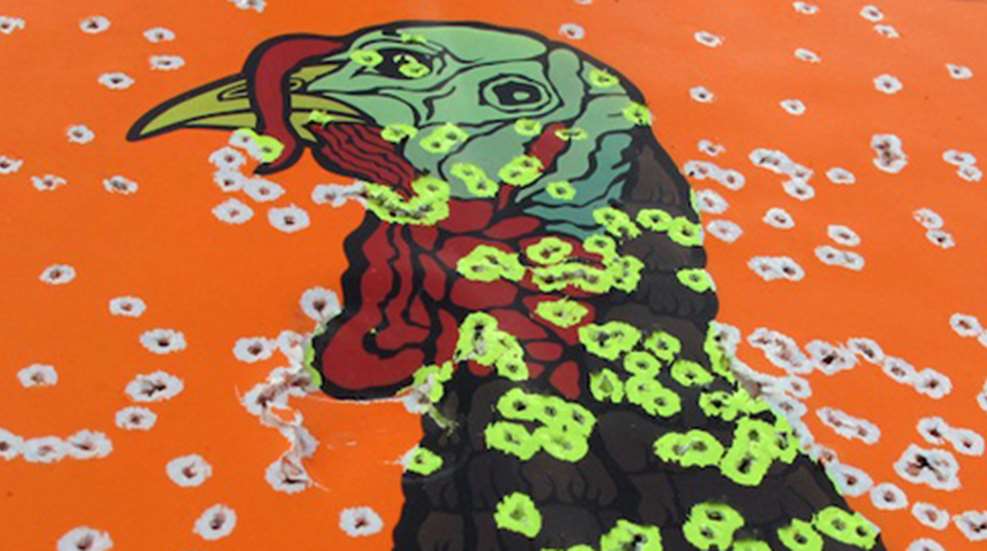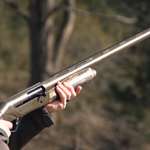
Deer and other big-game hunters have been groomed their entire hunting lives to aim for the heart and lung vitals of large-bodied hoofed animals in order to successfully bring them down. That may make shot placement on a wild turkey feel counterintuitive. Why? Because with a wild turkey, head and neck shots are the only way to go with a shotgun. A body shot on a heavily feathered, heavily muscled (in the chest) gobbler will likely lead to a bird that, while crippled, can still get away. Proper shot placement then is absolutely critical—perhaps more so than mastering your calling technique—to reliably punch your turkey tags each spring.
Taking Aim With a Shotgun
The quickest, surest way to drop a gobbler in its tracks is to deliver a tightly patterned load of No. 4, 5 or 6 shot right into the exposed head and neck area.
Why not the body? There are several reasons you want to avoid shooting a turkey in the body, the first being the fact that virtually all hunters are using fairly small-sized shot. Despite its penetrating abilities, the shot must pass through a gobbler’s thick cover of feathers, as well as its muscled chest, to strike a smallish heart and other vital organs. Unless a turkey is less than 20 yards away, much of the shot will not fully penetrate or find the organs it must to bring on a quick, clean kill. It’s just as well since the breasts, which the shot must pass through, also provide the primary meat a hunter will eat, and nobody wants to eat meat riddled with tooth-breaking shot.
When a turkey is in full strut, its feathers also make the body look much bigger than it really is, and a poorly aimed shot that looks like it is heading for the center of mass could cause the hunter to mistakenly miss any vitals as well.
The head, on the other hand, is small but exposed, and contains the brain, while the neck, also exposed except for when the bird is in full strut, contains the nerves and blood vessels that circulate both senses and blood to the spine and the rest of the organs. A bone-crushing shot to the head and neck immediately disrupts this flow and, except for the shattered avian reflexes of a dying bird, leaves the wild turkey feeling no pain and expiring within an instant.
But don’t just aim at the turkey’s head. If your point of aim is slightly high, you could miss the bird entirely. Instead, aim right above the line of feathers that join the fleshy part of gobbler’s neck. This allows the spread of shot to cover the entire area where the head and neck will be, while allowing some margin of error for a slightly misaimed shotgun, depending on how close the turkey is.
Making the Shot
When it comes time to take the shot, the turkey’s head and neck should be exposed from being extended. Try to avoid shooting a gobbler in full-strut, particularly when the tom is broadside to your position. In strut, the tom pulls its head and neck down tight against its puffed out chest, which provides more protection and can block much of the shot intended for the target area. I’ve seen hunters attempt shots at birds still in full-strut from the side, typically with two results.
If the bird is close enough, it will often collapse with an explosion of feathers as if a pillow has just been shot, because most of the shot strikes the body, riddling the facing breast with shot. In other instances, if the point of aim pulls ahead of the bird from a slapped trigger or torqued firearm, the turkey will scramble to its feet, even when hit, and require a follow-up shot. Those shots are often panicked shots that turn into a chase where the bird can often escape. Even if bloodied, finding a wounded turkey is near impossible, as the feathers soak up much, if not all, of the blood, leaving no trail to follow. In some cases, wounded turkeys can still take flight too, which adds to the likelihood of never finding the bird. A straight-on shot at a bird in strut can kill it, but almost always results in a shot off beard and peppered turkey breasts.
To pull a bird out of strut, cutt or cluck on your mouth call until the strutter stops and lifts his head up to see exactly what made the noise. Be ready to shoot as soon as the turkey lifts its head, because it is typically about to pinpoint you and get out of the area. I’ve seen guys yell something to the bird like “hey” or “get up” or things like that, but I’m not a big fan of doing that unless absolutely necessary. When you do that, the turkey is coming out of strut already alarmed and ready to bolt, which ultimately makes for more rushed—and missed—shots by hunters.
Distance Concerns
The range that produces the ideal spread from a modern high-performance turkey load and extra-full choke combination is between 20 and 30 yards. In that ballpark range, regardless of what you are shooting, shot density and energy are at their combined best. Based on recommendations from the Wild Turkey Task Force assembled by the National Wild Turkey Federation many years back, 40 yards has long been the suggested maximum distance for shooting at a wild turkey. This is admittedly still a good guideline, even with the much more powerful heavier-than-lead loads available to hunters, as it provides for some error on misjudging the distance between hunter and gobbler, particularly in open fields where everything looks closer.
For the practiced, however, many of these modern loads are admittedly capable of reliably taking birds out to 50 yards to 55 yards, though patterns are spreading and shot dropping even at that distance. Beyond that, it becomes a crap shoot, and every hunter owes it to the species to make sure that they take the most reliable, ethical shot they can.
As for close shots of 15 yards or less, these typically result in more misses than birds at the edge of a hunter’s maximum shooting range simply because the pattern has yet to open up. It’s more like shooting a single-projectile slug at a turkey than a cloud of shot, which is why I’m a fan of open, rifle-type shots on today’s turkey guns. Up close, precise aim becomes that much more critical.
Taking Aim With a Bow
For hunters using a bow and standard fixed-blade or mechanical broadheads, take everything that’s been written so far and scrap it. Blood loss—not shock and trauma—from a dense, blasted projectile is what is going to kill your bird, and anchoring the bird is the most critical factor to keep it from escaping. For this reason, if the bird is strutting and facing you, aim just above the beard and let the arrow fly. If the bird is strutting and turned away from you, aim right for the anal vent. Avoid side shots at strutting birds, as it can be difficult to positively determine where the body is aligned beneath all of those feathers.
One of the best shots to take when the bird is not in strut is a broadside shot aimed right at the butt of the wing feather. This will pin the wing to the body and prevent it from flying away before it expires. Many hunters like to reduce their draw weight to prevent pass through shots. With turkeys, a hunter wants the arrow still stuck in the bird.





































